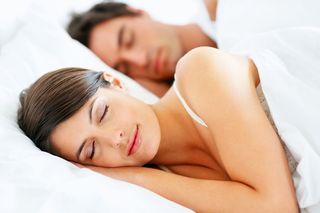Why Do People Sleepwalk?

If you've been recently rescued from sleepwalking, here's a possible reason why you went zombie — lack of sleep.
Sleepwalkers should keep a regular bedtime to avoid unwanted evening strolls, said Antonio Zadra of the Université de Montréal, who led a team that recently investigated the link between sleep loss and sleepwalking. Somnambulism, which affects up to 4 percent of adults, can cause mental confusion, bouts of amnesia and even physical injuries in those affected as they wander.
Sleepwalking is common in kids, but usually they outgrow it, says Dr. Vishesh Kapur, director of the University of Washington Sleep Disorders Center at Harborview Medical Center.
In the February 2008 issue of the journal Annals of Neurology, Zadra, Mathieu Pilon and Jacques Montplaisir explain how they evaluated 40 suspected sleepwalkers. Each was referred to the Sleep Research Centre at Sacré-Coeur Hospital, a Université de Montréal teaching hospital, between August 2003 and March 2007.
“Our study found that sleep deprivation can precipitate sleepwalking in predisposed individuals,” Zadra said.
Zzzzzzzzzz...
Subjects who took part in the study agreed to have their baseline sleep patterns monitored during an initial all-night assessment. During a subsequent visit, patients were kept awake for the entire evening and remained under constant supervision.
Sign up for the Live Science daily newsletter now
Get the world’s most fascinating discoveries delivered straight to your inbox.
Recovery sleep was allowed the next morning after patients had been awake for 25 hours. Subjects were videotaped during each sleep period as the research team evaluated their behavior, which ranged from playing with bed sheets to trying to jump over the bed rails. Subjects were evaluated on a three-point scale based on the complexity of their actions.
During baseline sleep, only half of patients exhibited some 32 of these behaviors. During recovery sleep, that figure rose to 90 percent. The research was supported by the Canadian Institutes of Health Research.
Sleepwalking is "a disorder of arousal, a kind of mixed state of being," Kapur said. There are three states of being in the world of sleep researchers — wakefulness, non-REM (rapid eye movement) sleep and REM sleep (most associated with dreams). Sleepwalking is a mixture of wakefulness and non-REM sleep, he said.
Some sort of arousal or disruption to sleep can also trigger sleepwalking, Kapur said. So people with sleep apnea (an interruption of breathing — snoring is commonly caused by apnea) sometimes sleepwalk, because apnea can create a state where someone is in between non-REM sleep and wakefulness.
Genes to jammies
Family genetics can also predispose one to sleepwalking, Kapur said, but a lot is still unknown about why some people sleepwalk and others do not.
[ Wake Up! The Real Facts on Sleepwalking (Infographic)]
"We know that sleepwalking happens more often in children than in adults, and the predisposing factor there might be the fact that kids have a lot more of slow-wave sleep, a deep non-REM sleep where sleepwalking often starts," Kapur said.
One of the main concerns with sleep walking is injury to oneself or others. When there is any issue of complex behavior that has someone leaving the home or potentially doing activities that could hurt them, they should be evaluated and treated, Kapur said.
Treatments for sleep walking include better sleep hygiene, keeping a regular sleep schedule (to avoid sleep deprivation) and avoiding an excess of alcohol and caffeine or maybe any at all, particularly in the evening, he said. For extreme cases, medication may be prescribed.
Follow Life's Little Mysteries on Twitter @llmysteries. We're also on Facebook & Google+.
Robin Lloyd was a senior editor at Space.com and Live Science from 2007 to 2009. She holds a B.A. degree in sociology from Smith College and a Ph.D. and M.A. degree in sociology from the University of California at Santa Barbara. She is currently a freelance science writer based in New York City and a contributing editor at Scientific American, as well as an adjunct professor at New York University's Science, Health and Environmental Reporting Program.
Most Popular


